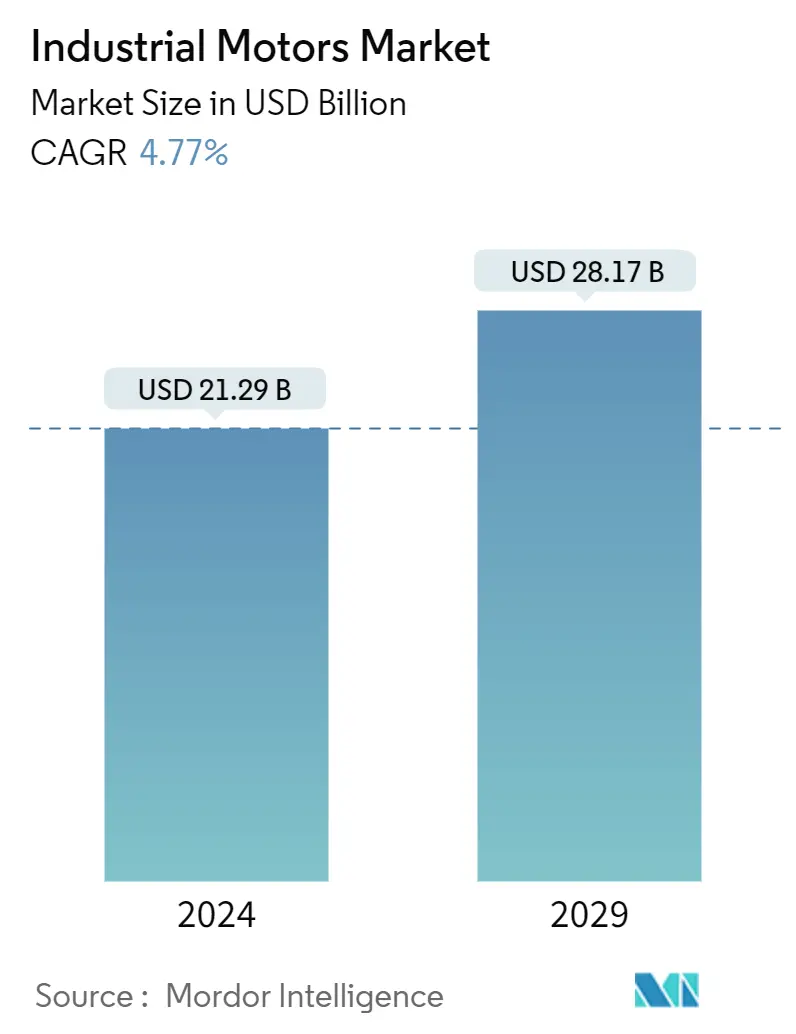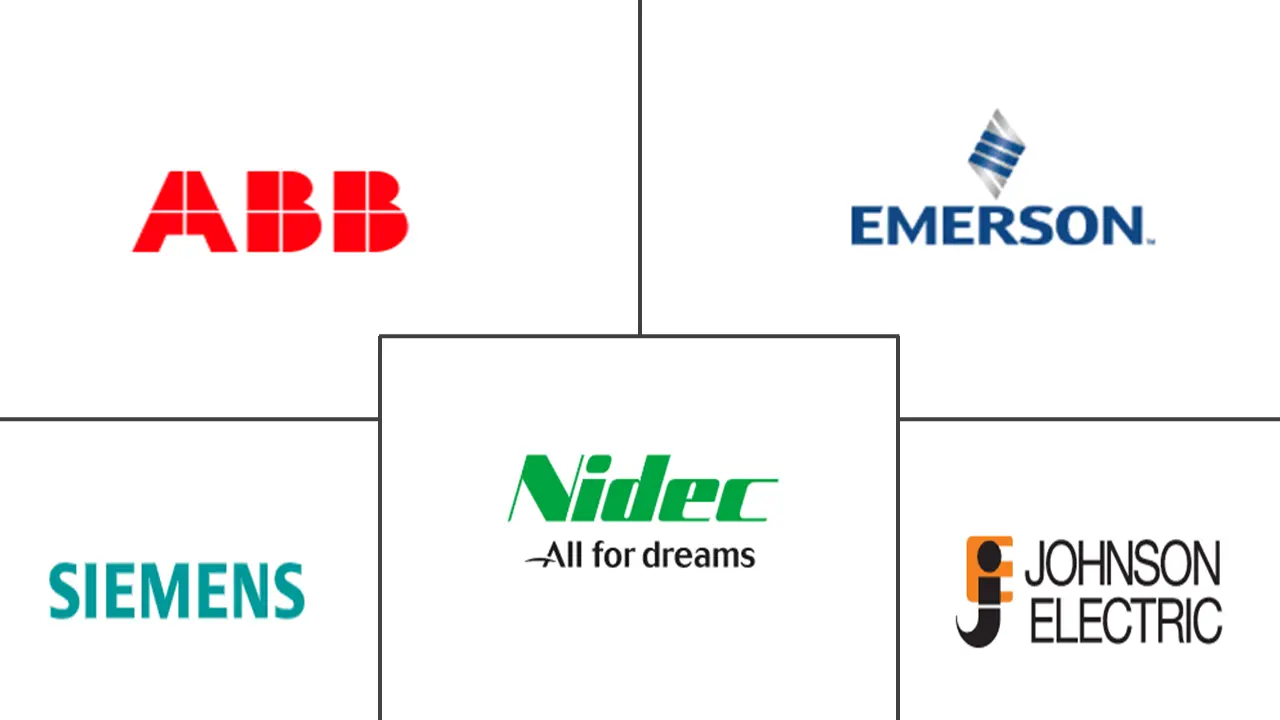Market Size of Industrial Motors Industry

| Study Period | 2019 - 2029 |
| Market Size (2024) | USD 21.29 Billion |
| Market Size (2029) | USD 28.17 Billion |
| CAGR (2024 - 2029) | 4.77 % |
| Fastest Growing Market | Asia-Pacific |
| Largest Market | Asia Pacific |
Major Players
*Disclaimer: Major Players sorted in no particular order |
Industrial Motors Market Analysis
The Industrial Motors Market size is estimated at USD 21.29 billion in 2024, and is expected to reach USD 28.17 billion by 2029, growing at a CAGR of 4.77% during the forecast period (2024-2029).
The expanding footprint of the industrial sector across developing regions, along with the growing penetration of advanced machinery and automation, supports the studied market's growth.
- Motors are the significant driving force of industrial production. The new and advanced approaches for designing and developing industrial motors include factors like alignment, motor monitoring, connections, testing, and saving costs and time while improving safety and security. Energy-saving motors and intelligent drives also boost efficiency and performance while facilitating troubleshooting.
- The growing focus on Industry 4.0 primarily drives the market for industrial motors. Industrial automation drives the manufacturing sector toward more productivity in several regions, expecting to show strong demand. According to Industrial Energy Accelerator, nearly 70% of all electrical energy consumed by several industries is used by the millions of electrical motors installed globally. Such trends drive the demand for innovations in industrial motor technology to make them energy efficient.
- The industry players also focus on expanding their manufacturing operations, further supporting the market growth. For instance, in July 2022, Mitsubishi Electric Corporation revealed that it would fund the construction of a new factory in India by investing roughly JPY 3.1 billion (USD 20753139), or EUR 21.8 million (USD 23078570), in its subsidiary Mitsubishi Electric India Pvt. Ltd. The new facility, whose activities are scheduled to begin in December 2023, will likely produce inverters and other factory automation (FA) control system goods, enhancing the company's capacity to satisfy India's booming demand. Such an instance will create a favorable outlook for the growth of the studied market in the region.
- In Industrial applications, AC motors are generally more reliable with low maintenance requirements, and the bearing life frequently limits the service life of AC motors. Since the motors do not need commutators, brushes, or slip rings, they don't have parts that wear out regularly. This factor makes the motors ideal for applications that are not easily accessible, continuously available to operate, or will work without supervision for long periods. Furthermore, one critical trend in the market is the development of high power-to-weight ratio industrial motors. Several manufacturers are developing electric motors with a high power-to-weight ratio, as large electric motors have portability and high energy consumption issues.
- However, factors such as the higher installation and maintenance cost of industrial motors challenge the growth of the studied market, especially in developing markets, wherein price sensitivity is higher.
- The impact of macroeconomic factors is also on the higher side in the studied market, as investments in the industrial sector are largely influenced by factors such as the market demand for manufactured products, the general economic condition of the region, and the geopolitical situation. Hence, during the forecast period, these factors are anticipated to continue to play a pivotal role in determining the growth trajectory of the studied market.
Industrial Motors Industry Segmentation
An industrial motor is an electric motor that converts electricity into mechanical energy. These motors produce rotary or linear forces and are typically powered by alternating current (AC) resources such as power grids or generators. However, some may be supplied by direct current (DC) resources like batteries.
The industrial motors market is segmented by type of motor (alternating current (AC) motors, direct current (DC) motors), voltage (high voltage, medium voltage, low voltage), end-user (oil and gas, power generation, mining, and metals, water and wastewater management, chemicals and petrochemicals, discrete manufacturing), and by geography (North America, Europe, Asia-Pacific, Latin America, Middle East and Africa). The market sizes and forecasts are provided in terms of value (USD) for all the above segments.
| By Type of Motor | |
| Alternating Current (AC) Motors | |
| Direct Current (DC) Motor | |
| Other Types of Motors (Servo and Electronically Commutated Motors (EC)) |
| By Voltage | |
| High Voltage | |
| Medium Voltage | |
| Low Voltage |
| By End User | |
| Oil and Gas | |
| Power Generation | |
| Mining and Metals | |
| Water and Wastewater Management | |
| Chemicals and Petrochemicals | |
| Discrete Manufacturing | |
| Other End Users |
| By Geography | ||||||
| ||||||
| ||||||
| ||||||
| ||||||
|
Industrial Motors Market Size Summary
The industrial motors market is poised for significant growth, driven by the expanding industrial sector in developing regions and the increasing adoption of advanced machinery and automation. Industrial motors play a crucial role in driving industrial production, with innovations in design and technology enhancing efficiency, safety, and energy savings. The focus on Industry 4.0 and industrial automation is propelling demand for motors, as they are integral to improving productivity across various sectors. The market is also witnessing a trend towards energy-efficient and intelligent motor solutions, which are essential for meeting the energy consumption demands of industries globally. However, challenges such as high installation and maintenance costs, particularly in price-sensitive developing markets, and the impact of macroeconomic factors, continue to influence market dynamics.
The market landscape is characterized by a fragmented structure with numerous players, including prominent companies like ABB Group, Siemens AG, and Emerson Electric Co. Inc. These companies are leveraging innovation to maintain a competitive edge, with recent developments such as ABB's acquisition of Siemens' low voltage NEMA motor business and the launch of new motor architectures by Electrified Automation. The demand for low-voltage motors is expected to rise, particularly in the oil and gas sector, driven by regulatory standards and rising oil prices. Additionally, regions like Asia Pacific, especially China and India, are witnessing a surge in industrial motor adoption due to smart manufacturing initiatives and increased exploration in the oil and gas industry. This regional growth, coupled with the ongoing transformation in Southeast Asia, is anticipated to create a favorable outlook for the industrial motors market over the forecast period.
Industrial Motors Market Size - Table of Contents
-
1. MARKET INSIGHTS
-
1.1 Market Overview
-
1.2 Industry Attractiveness - Porter's Five Forces Analysis
-
1.2.1 Bargaining Power of Suppliers
-
1.2.2 Bargaining Power of Buyers/Consumers
-
1.2.3 Threat of New Entrants
-
1.2.4 Threat of Substitute Products
-
1.2.5 Intensity of Competitive Rivalry
-
-
1.3 Impact of Macro Trends on the Industrial Motors Market
-
-
2. MARKET SEGMENTATION
-
2.1 By Type of Motor
-
2.1.1 Alternating Current (AC) Motors
-
2.1.2 Direct Current (DC) Motor
-
2.1.3 Other Types of Motors (Servo and Electronically Commutated Motors (EC))
-
-
2.2 By Voltage
-
2.2.1 High Voltage
-
2.2.2 Medium Voltage
-
2.2.3 Low Voltage
-
-
2.3 By End User
-
2.3.1 Oil and Gas
-
2.3.2 Power Generation
-
2.3.3 Mining and Metals
-
2.3.4 Water and Wastewater Management
-
2.3.5 Chemicals and Petrochemicals
-
2.3.6 Discrete Manufacturing
-
2.3.7 Other End Users
-
-
2.4 By Geography
-
2.4.1 North America
-
2.4.1.1 United States
-
2.4.1.2 Canada
-
-
2.4.2 Europe
-
2.4.2.1 United Kingdom
-
2.4.2.2 Germany
-
2.4.2.3 France
-
2.4.2.4 Rest of Europe
-
-
2.4.3 Asia-Pacific
-
2.4.3.1 China
-
2.4.3.2 Japan
-
2.4.3.3 India
-
2.4.3.4 Rest of Asia-Pacific
-
-
2.4.4 Latin America
-
2.4.4.1 Brazil
-
2.4.4.2 Argentina
-
2.4.4.3 Rest of Latin America
-
-
2.4.5 Middle East and Africa
-
2.4.5.1 Saudi Arabia
-
2.4.5.2 South Africa
-
2.4.5.3 Rest of Middle East and Africa
-
-
-
Industrial Motors Market Size FAQs
How big is the Industrial Motors Market?
The Industrial Motors Market size is expected to reach USD 21.29 billion in 2024 and grow at a CAGR of 4.77% to reach USD 28.17 billion by 2029.
What is the current Industrial Motors Market size?
In 2024, the Industrial Motors Market size is expected to reach USD 21.29 billion.

